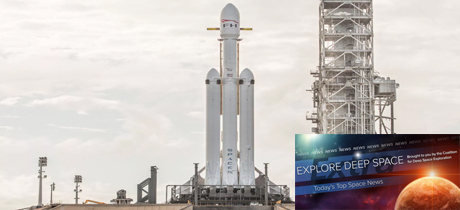In Today’s Deep Space Extra… U.S. investments in space technology and exploration support global leadership, promise economic dividends, inspiration. James Webb Space Telescope (JWST) moves to Northrop Grumman in Redondo Beach for next round of pre-launch testing. Trappist-1 planets rocky with water in some form. Falcon Heavy poised for Florida liftoff.
Human Space Flight
Space exploration is good for American jobs
The Hill (2/5): U.S. investment in space exploration pays dividends through innovation and future economic growth as well as cementing U.S. leadership in the field, writes David Logsdon, senior director of the COMP TIA Space Enterprise Council, in an op ed. “Continued funding would not only reaffirm the country’s leadership in space and allow travel to previously untouched lands, but also enable the commercialization of highly innovative technology and support tens of thousands of American jobs,” he says of NASA’s Space Launch System (SLS) and Orion deep space exploration initiatives.
Whittington: Let humans, not robots, explore the moon
Houston Chronicle (2/5): Human scientific intelligence and physical skills can top those of robots in exploring the fundamental field geology of the lunar surface, assessing access to potential resources and offering inspiration to planet Earth, says Mark Whittington, who has written on space politics, in an op-ed.
Mars atmospheric dust and human exploration
The Space Review (2/5): The Apollo astronauts, NASA engineers and mission planners were surprised by the challenges presented by moon dust. Mars, a future destination for human explorers, is also no stranger to dust, with some storms reaching global status. Some scientists are urging studies to nail down the chemical and electrical properties of Martian dust particles and the role they might play in exposing the red planet to unwanted terrestrial microorganisms.
Space Science
Coalition Member in the News: Northrop Grumman
Northrop Grumman/NASA Goddard (2/5): After months of thermal vacuum testing at NASA’s Johnson Space Center in Houston, the large James Webb Space Telescope’s (JWST) optical systems and science instruments have journeyed to prime contractor Northrop Grumman Aerospace Systems in Redondo Beach, California, where they are to join the space telescope’s bus for integrated testing this summer. The powerful telescope, which includes the European and Canadian space agencies as partners, is to launch from Kourou, French Guiana in 2019 atop an Ariane 5 rocket.
Two telescopes reveal new clues to TRAPPIST-1 planet compositions, atmospheres
NASA (2/5): It’s been a year since NASA announced the discovery of the Trappist-1 planetary system with seven Earth like planets just 40 light years away. Follow on observations with NASA’s Kepler and Spitzer space telescopes reveal that all seven are rocky and the mass of the alien worlds is 5 percent water, dozens of times more than found on Earth. Three have hydrogen rich atmospheres, according to observations with the Hubble Space Telescope. The findings are published in the journal Nature Astronomy and the Astronomy and Astrophysics Journal. Moving toward a launch in 2019, the powerful James Webb Space Telescope, whose development is led by NASA, will study their atmospheres for signs of biomarkers.
Universe Today (2/5): The Trace Gas Orbiter portion of the joint European/Russian ExoMars mission, launched in March 2016 with its ill-fated Schiaparelli lander companion, is settling into its intended operational orbit around the red planet by aerobraking. The orbiter’s mission is to search for biomarkers associated with past biological activity on Mars and identify candidate landing sites for future missions. Schiaparelli crashed as the two spacecraft reached Mars in October 2016.
Astronomers detect a swarm of tiny objects orbiting an alien sun
Space.com (2/5): Astronomers have spotted what appears to be small comets orbiting two stars, KIC 11084727 and KIC 3542116, both yellow dwarfs. They are among the smallest objects detected by NASA’s Kepler exo-planet seeking space telescope.
Other News
Elon Musk says the Falcon Heavy has a 50-50 chance of success
Ars Technica (2/5): On the eve of SpaceX’s first Falcon Heavy launch, company founder and CEO Elon Musk dims expectations of success, admitting he’s concerned over interactions among the 27 core stage engines. Liftoff from NASA’s Kennedy Space Center is set for 1:30 p.m., EST, the opening of a 2 1/2 hour launch window.
How long will the money keep flowing?
The Space Review (2/5): Last year saw billions of private equity flow to space companies. What happens next, though, is not clear. Will the space surge continue, or be diverted to new Silicon Valley ventures? TSR editor Jeff Foust breaks down the thinking from those attending the Space Tech Summit, a conference hosted last month in San Mateo, California.

